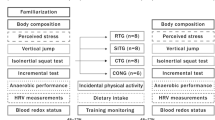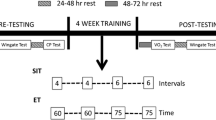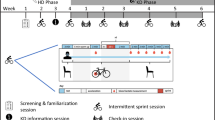Abstract
Purpose
The primary purpose of this study was to examine the influence of different work-to-rest ratios on relative energy system utilization during short-term upper-body sprint interval training (SIT) protocols.
Methods
Forty-two recreationally trained men were randomized into one of three training groups [10 s work bouts with 2 min of rest (10:2, n = 11) or 4 min of rest (10:4, n = 11), or 30 s work bouts with 4 min of rest (30:4, n = 10)] or a control group (CON, n = 10). Participants underwent six training sessions over 2 weeks with 4–6 ‘all-out’ sprints. Participants completed an upper body Wingate test (30 s ‘all-out’ using 0.05 kg kg−1 of the participant’s body mass) pre- and post-intervention from which oxygen consumption and blood lactate were used to estimate oxidative, glycolytic, and adenosine triphosphate-phosphocreatine (ATP-PCr) energy system provisions. An analysis of covariance was performed on all testing measurements collected at post with the associated pre-values used as covariates.
Results
Relative energy contribution (p = 0.026) and energy expenditure (p = 0.019) of the ATP-PCr energy system were greater in 10:4 (49.9%; 62.1 kJ) compared to CON (43.1%; 47.2 kJ) post training. No significant differences were found between groups in glycolytic or oxidative energy contribution over a 30 s upper body Wingate test.
Conclusion
SIT protocols with smaller work-to-rest ratios may enhance ATP-PCr utilization in a 30 s upper body Wingate over a 2-week intervention.



Similar content being viewed by others
Abbreviations
- ATP-PCr:
-
Adenosine triphosphate-phosphocreatine
- CON:
-
Control group
- EPOC:
-
Excess post-exercise oxygen consumption
- MP:
-
Average mean power
- PAR-Q+:
-
Physical activity readiness questionnaire
- PP:
-
Average peak power
- PRR:
-
Perceived readiness rating
- SIT:
-
Sprint interval training
- TW:
-
Average total work
- V̇O2peak :
-
Peak oxygen uptake
- 30:4:
-
30 S sprints with 4 min of rest
- 10:4:
-
10 S sprints with 4 min of rest
- 10:2:
-
10 S sprints with 2 min of rest
References
Allen DG, Lamb GD, Westerblad H (2008) Impaired calcium release during fatigue. J Appl Physiol 104(1):296–305
Beneke R, Pollmann C, Bleif I, Leithäuser R, Hütler M (2002) How anaerobic is the Wingate anaerobic test for humans? Eur J Appl Physiol 87(4–5):388–392
Bertuzzi R, Melegati J, Bueno S, Ghiarone T, Pasqua LA, Gáspari AF et al (2016) GEDAE-LaB: a free software to calculate the energy system contributions during exercise. PLoS ONE 11(1):e0145733
Bogdanis GC, Nevill ME, Boobis LH, Lakomy HK (1996) Contribution of phosphocreatine and aerobic metabolism to energy supply during repeated sprint exercise. J Appl Physiol 80(3):876–884
Bogdanis G, Nevill M, Lakomy H, Boobis L (1998) Power output and muscle metabolism during and following recovery from 10 and 20 s of maximal sprint exercise in humans. Acta Physiol 163(3):261–272
Buchheit M, Laursen PB (2013) High-intensity interval training, solutions to the programming puzzle. Sports Med 43(10):927–954
Burgomaster KA, Hughes SC, Heigenhauser GJ, Bradwell SN, Gibala MJ (2005) Six sessions of sprint interval training increases muscle oxidative potential and cycle endurance capacity in humans. J Appl Physiol 98(6):1985–1990. https://doi.org/10.1152/japplphysiol.01095.2004
Burgomaster KA, Heigenhauser GJ, Gibala MJ (2006) Effect of short-term sprint interval training on human skeletal muscle carbohydrate metabolism during exercise and time-trial performance. J Appl Physiol 100(6):2041–2047. https://doi.org/10.1152/japplphysiol.01220.2005
Cairns SP (2006) Lactic acid and exercise performance. Sports Med 36(4):279–291
Cohen J (1988) Statistical power analysis for the behavioral sciences, 2nd edn. L. Erlbaum Associates, Hillsdale
de Poli R, Roncada LH, Malta ES, Artioli GG, Bertuzzi R, Zagatto AM (2019) Creatine supplementation improves phosphagen energy pathway during supramaximal effort, but does not improve anaerobic capacity or performance. Front Physiol 10:352. https://doi.org/10.3389/fphys.2019.00352
di Prampero PE, Ferretti G (1999) The energetics of anaerobic muscle metabolism: a reappraisal of older and recent concepts. Respir Physiol 118(2):103–115
Forbes SC, Paganini AT, Slade JM, Towse TF, Meyer RA (2009) Phosphocreatine recovery kinetics following low and high intensity exercise in human triceps surae and rat posterior hindlimb muscles. Am J Physiol Regulat Integr Compar Physiol 296(1):R161–R170
Franchini E, Takito MY, Kiss MAPDM (2016) Performance and energy systems contributions during upper-body sprint interval exercise. J Exerc Rehabilit 12(6):535
Gaitanos GC, Williams C, Boobis LH, Brooks S (1993) Human muscle metabolism during intermittent maximal exercise. J Appl Physiol 75(2):712–719
García-Pallarés J, López-Gullón JM, Muriel X, Díaz A, Izquierdo M (2011) Physical fitness factors to predict male olympic wrestling performance. Eur J Appl Physiol 111(8):1747–1758
Garrett WE, Kirkendall DT (2000) Exercise and sport science. Lippincott Williams & Wilkins, Philadelphia
Gastin P (2001) Energy system interaction and relative contribution during maximal exercise. Sports Med 31(10):725–741
Gillen JB, Percival ME, Skelly LE, Martin BJ, Tan RB, Tarnopolsky MA, Gibala MJ (2014) Three minutes of all-out intermittent exercise per week increases skeletal muscle oxidative capacity and improves cardiometabolic health. PLoS ONE 9(11):e111489
Girard O, Mendez-Villanueva A, Bishop D (2011) Repeated-sprint ability—part I. Sports Med 41(8):673–694
Harvey L, Bousson M, McLellan C, Lovell DI (2015) The effect of high intensity intermittent exercise on power output for the upper body. Sports 3(3):136–144
Haseler LJ, Hogan MC, Richardson RS (1999) Skeletal muscle phosphocreatine recovery in exercise-trained humans is dependent on O2 availability. J Appl Physiol 86(6):2013–2018
Hazell TJ, MacPherson RE, Gravelle BM, Lemon PW (2010) 10 or 30-s sprint interval training bouts enhance both aerobic and anaerobic performance. Eur J Appl Physiol 110(1):153–160
Horswill C, Miller J, Scott J, Smith C, Welk G, Van Handel P (1992) Anaerobic and aerobic power in arms and legs of elite senior wrestlers. Int J Sports Med 13(08):558–561
Iaia FM, Fiorenza M, Perri E, Alberti G, Millet GP, Bangsbo J (2015) The effect of two speed endurance training regimes on performance of soccer players. PLoS ONE 10(9):e0138096
Jacobs RA, Fluck D, Bonne TC, Burgi S, Christensen PM, Toigo M, Lundby C (2013) Improvements in exercise performance with high-intensity interval training coincide with an increase in skeletal muscle mitochondrial content and function. J Appl Physiol 115(6):785–793. https://doi.org/10.1152/japplphysiol.00445.2013
Julio UF, Panissa VL, Cury RL, Agostinho MF, Esteves JV, Franchini E (2019) Energy system contributions in upper and lower body wingate tests in highly trained athletes. Res Quart Exerc Sport 90(2):244–250. https://doi.org/10.1080/02701367.2019.1576839
Koukoubis T, Cooper L, Glisson R, Seaber A, Feagin J (1995) An electromyographic study of arm muscles during climbing. Knee Surg Sports Traumatol Arthrosc 3(2):121–124
La Monica MB, Fukuda DH, Starling-Smith TM, Clark NW, Morales J, Hoffman JR, Stout JR (2019) Examining work-to-rest ratios to optimize upper body sprint interval training. Respir Physiol Neurobiol 262:12–19
Lloyd Jones MC, Morris MG, Jakeman JR (2017) Impact of time and work: rest ratio matched sprint interval training programmes on performance: a randomised controlled trial. J Sci Med Sport 20(11):1034–1038. https://doi.org/10.1016/j.jsams.2017.03.020
Lovell DI, Mason D, Delphinus E, McLellan C (2013) Upper and lower body anaerobic performance of semi-elite rugby league players. J Sports Med Phys Fitness 53(5):477–482
MacDougall JD, Hicks AL, MacDonald JR, McKelvie RS, Green HJ, Smith KM (1998) Muscle performance and enzymatic adaptations to sprint interval training. J Appl Physiol 84(6):2138–2142
Margaria R, Edwards H, Dill D (1933) The possible mechanisms of contracting and paying the oxygen debt and the role of lactic acid in muscular contraction. Am J Physiol Legacy Content 106(3):689–715
McMahon S, Jenkins D (2002) Factors affecting the rate of phosphocreatine resynthesis following intense exercise. Sports Med 32(12):761–784
Mendez-Villanueva A, Edge J, Suriano R, Hamer P, Bishop D (2012) The recovery of repeated-sprint exercise is associated with PCr resynthesis, while muscle pH and EMG amplitude remain depressed. PLoS ONE 7(12):e51977
Parra J, Cadefau J, Rodas G, Amigo N, Cusso R (2000) The distribution of rest periods affects performance and adaptations of energy metabolism induced by high-intensity training in human muscle. Acta Physiol 169(2):157–165
Price M, Beckford C, Dorricott A, Hill C, Kershaw M, Singh M, Thornton I (2014) Oxygen uptake during upper body and lower body Wingate anaerobic tests. Appl Physiol Nutr Metab 39(12):1345–1351
Roberts A, Morton A (1978) Total and alactic oxygen debts after supramaximal work. Eur J Appl Physiol 38(4):281–289
Sloth M, Sloth D, Overgaard K, Dalgas U (2013) Effects of sprint interval training on VO2max and aerobic exercise performance: a systematic review and meta-analysis. Scand J Med Sci Sports 23(6):e341–e352
Tabachnick B, Fidell L (2013) Using multivariate statistics, 6th edn. Sage Publications, Thousand Oaks, CA
Yamagishi T, Babraj J (2017) Effects of reduced-volume of sprint interval training and the time course of physiological and performance adaptations. Scand J Med Sci Sports 27(12):1662–1672
Zelt JG, Hankinson PB, Foster WS, Williams CB, Reynolds J, Garneys E, Gurd BJ (2014) Reducing the volume of sprint interval training does not diminish maximal and submaximal performance gains in healthy men. Eur J Appl Physiol 114(11):2427–2436
Zinner C, Morales-Alamo D, Ortenblad N, Larsen FJ, Schiffer TA, Willis SJ et al (2016) The physiological mechanisms of performance enhancement with sprint interval training differ between the upper and lower extremities in humans. Front Physiol 7:426. https://doi.org/10.3389/fphys.2016.00426
Author information
Authors and Affiliations
Contributions
ML—study design, manuscript writing, data collection, data analysis, revising and editing. DF—study design, manuscript writing, data analysis, revising and editing. TS—data collection, data analysis, revising and editing. NC—data collection, data analysis, revising and editing. VP—manuscript writing, data collection, data analysis, revising and editing.
Corresponding author
Ethics declarations
Conflict of interest
The authors have no conflicts of interest to report.
Additional information
Communicated by Philip D Chilibeck.
Publisher's Note
Springer Nature remains neutral with regard to jurisdictional claims in published maps and institutional affiliations.
Rights and permissions
About this article
Cite this article
La Monica, M.B., Fukuda, D.H., Starling-Smith, T.M. et al. Alterations in energy system contribution following upper body sprint interval training. Eur J Appl Physiol 120, 643–651 (2020). https://doi.org/10.1007/s00421-020-04304-w
Received:
Accepted:
Published:
Issue Date:
DOI: https://doi.org/10.1007/s00421-020-04304-w




